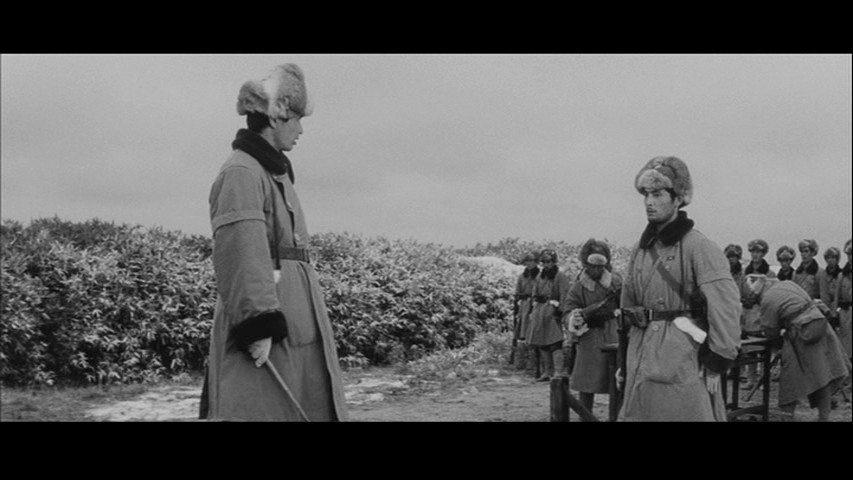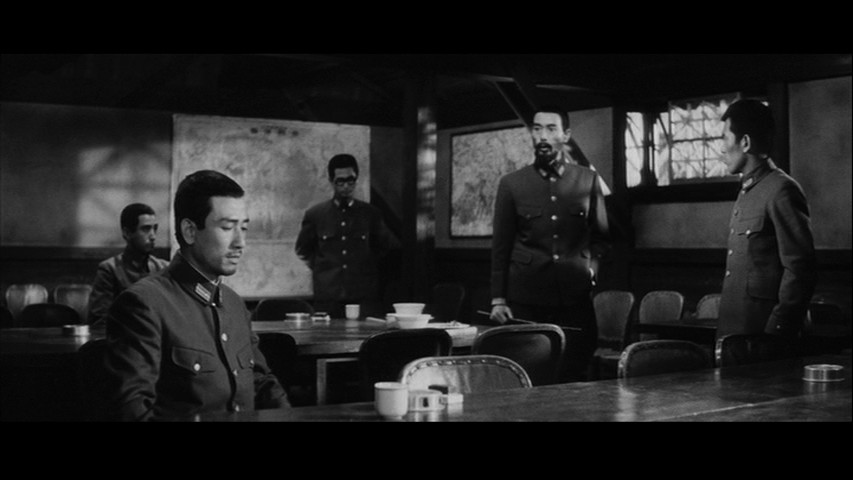The Human Condition

See more details, packaging, or compare
Synopsis
Masaki Kobayashi’s mammoth humanist drama is one of the most staggering achievements of Japanese cinema. Originally filmed and released in three parts, the nine-and-a-half-hour The Human Condition (Ningen no joken), adapted from Junpei Gomikawa’s six-volume novel, tells of the journey of the well-intentioned yet naive Kaji (handsome Japanese superstar Tatsuya Nakadai) from labor camp supervisor to Imperial Army soldier to Soviet POW. Constantly trying to rise above a corrupt system, Kaji time and again finds his morals an impediment rather than an advantage. A raw indictment of its nation’s wartime mentality as well as a personal existential tragedy, Kobayashi’s riveting, gorgeously filmed epic is novelistic cinema at its best.
Picture 7/10
Criterion presents Masaki Kobayashi’s trilogy The Human Condition in the aspect ratio of 2.35:1 over three dual-layer discs of this four disc set. The image has been enhanced for widescreen televisions.
While the image can be problematic at times I was more than happy with it overall. The quality of the transfers is about equal between the three films and I can’t say I noticed a substantial difference between them. There’s excellent definition and detail through a majority of the film and blacks and whites look sharp. The image has been restored beautifully and there is very little in the way of damage, limited to some marks and a few scratches that periodically show up. A lot of the damage or shifts in the quality in the print are more apparent when Japanese subtitles are displayed. Criterion’s DVD of course has optional English subtitles but Japanese subtitles, which translates what I assume to be Mandarin dialogue for the Chinese characters in the film and Russian from the Soviet characters, are burned in on the right side of the screen. When these subtitles display damage becomes more apparent and contrast can shift.
There are some digital artifacts and noise noticeable in some blacks and in the sky in many sequences unfortunately. Edge-enhancement can rear its ugly head but there were only a few occasions where I felt it really stood out.
Still as a whole it’s about what I hoped for. Each disc contains at least 3 hours of film so I’m sure this is limiting, but Criterion has still managed to deliver a nice looking black and white transfer. I hope it will make its way to Blu-ray sometime soon.




































Audio 6/10
The first two films come with Japanese Dolby Digital 1.0 mono tracks, and quality wise they’re about the same and nothing really spectacular coming off a little flat and edgy, music and voices (when they’re yelling at least) sounding harsh.
The third film comes with a Dolby Digital 4.0 surround track, which is a little sharper than the mono tracks and a bit of a shock when you move to it from the second film’s mono track. Though limited to the front three speakers primarily (the rears, working together, only present some subtle background noises and music that you actually have to work to hear) the stereo effects are faultless and move naturally between the speakers. What did catch me a little off guard at first were voices. They sounded a little odd at first and I wasn’t quite sure what it was until I realized that the voices were actually being spread out between the three front speakers and not just limited to the center as I’m used to. I assume this is in the source since the rest of the audio that appears in the film is actually split between the speakers, and there are noticeable moments where a character’s voice is more apparent in the left or right speaker depending on their position on screen. This isn’t a huge issue, though, just odd at first but it wasn’t noticeable after a while.
As a whole they’re decent tracks, with the mono ones coming off more problematic. The surround track for the last film isn’t a great surround track but it’s cleaner and a little more robust than the others.
Extras 6/10
Considering the ambitions and how massive this four-disc set looks in your hands there’s surprisingly very little on here about the film(s), supplements totaling just over an hour. Though I must admit after 9 and half hours I don’t think I could have endured a considerable number of supplements. The first three discs are devoted to their respective films while the fourth single-layer DVD contains all of the release’s supplements.
The first supplement is a 14-minute 1993 interview with director Masaki Kobayashi, which was recorded for the Director’s Guild of Japan. Fellow director Masahiro Shinoda (who also provides an interview on this disc) interviews the director about the long, difficult shoot that for The Human Condition, going over various aspects of it including the cinematographer and casting Tatsuya Nakadai. There’s also mention of footage that was cut, a lot of it by the sounds of it, but unfortunately this material was tossed away and is lost for good. He also mentions some of the awards the film won and the harsh critical reception the first film received, followed by a brief discussion about storyboarding that ends up covering more about Ozu’s technique in storyboarding than his Kobayashi’s own. It’s a decent interview but unfortunately short, focuses more on the first film, and I suspect the segments shown here are edited together from a much larger interview with the director that more than likely covered his career as a whole. Disappointing but I would go on to further guess Criterion might be saving more of it for some other future release (like maybe a reissue of Kwaidan one would hope…)
The next interview with actor Tatsuya Nakadai is a newer one recorded exclusively for Criterion. Lasting almost 17-minutes, Nakadai reflects on the lengthy 3 year production and the film itself, and sounds surprised he even got the role, which was his first lead and at that point it was different from most of his other roles. He recalls amusingly the more physical aspects of the part that he would fear doing today, which included ducking under an oncoming tank, doing actual drills and training, and lying out in the snow for an extended period. He also points out Kobayashi’s insistence on being as faithful to the novels as possible, and while he doesn’t know exactly how the author, Junpei Gomikawa, felt about the finished film the writer did say “good job!” to Nakadai, which he took as praise. Thrown in are photos of magazine covers featuring the film, and there’s even an amusing shot of a photo from an article showing all the film cans for the movies. It’s a nice expansion on the Kobayashi interview, providing further insight into the film from someone who was on the set.
The final interview is with director Masahiro Shinoda, who gives an appreciation of the film and of Kobayashi. He begins with the mindset of Japan after the war (mentioning that this film could have probably only been made during that period and would probably not get made today) and then gets into Kobayashi’s military career, which shares similarities not only with the film’s main character, Kaji, but of the books’ author. Like Kaji, Kobayashi had extreme leftist views that drastically changed after he learned of the Soviet’s treatment of their Japanese prisoners, which were far more extreme when compared with his experience in an American POW camp. From there he then talks about the film trilogy, the various themes, compares it to Renoir’s Grand Illusion, it’s depiction of the Chinese and then its depiction of the Chinese view of the Japanese. He then brings up how the younger generation sees the film, which he based on research he did on the internet. It’s a decent interview that makes up for the lack of a commentary in a way. Plus there are photos of what I assume are the books Kobayashi used in making the film, with notes visible on the pages. In all this feature runs shy of 25-minutes.
The disc then concludes with three theatrical trailers, one for each film. In total they run about 10-minutes and are pretty standard stuff.
I would have expected a thick booklet for this release but disappointingly Criterion unfortunately only includes an insert that folds out to reveal a six page essay by Philip Kemp. It’s a decent read and adds a more analytical component to the set.
The lack of a commentary may miff a few but in all honesty I was actually somewhat glad there wasn’t one here. At nine and a half hours that would be pushing it. I’m sure even a selected scene track would be too much. And while I know there’s more material out there on this film, and I’m sure an intriguing making-of documentary could be made about the film’s production, I was still satisfied with what was on here, and the supplements do cover the film decently enough.
Closing
I had only seen Image Entertainments disc for the first film (parts 1 and 2) and it was pretty disastrous. I can only assume the other discs were just as bad and based on that not only do I recommend this set to people who don’t own the film on DVD but to those that own those previous DVDs. Criterion’s transfer is far sharper and crisper than the Image disc (again, based only on the first disc) and is about as good as most of Criterion’s other black and white transfers. Plus the supplements, while slim, are rewarding enough. One of my favourite releases from them so far this year and I found it to be well worth the wait.







